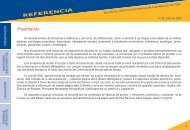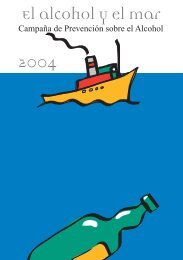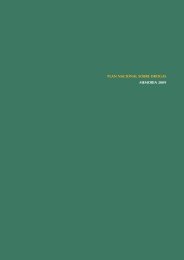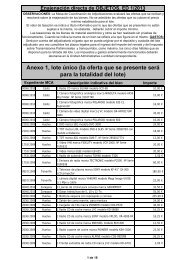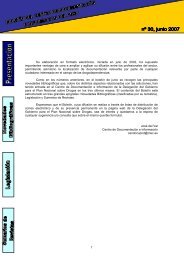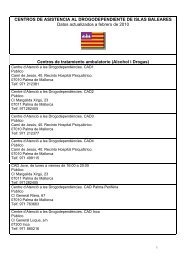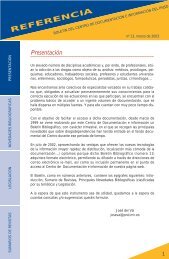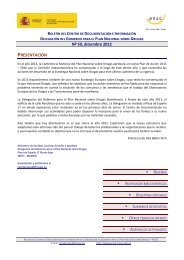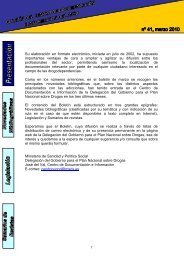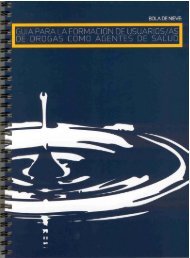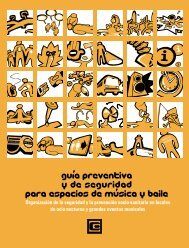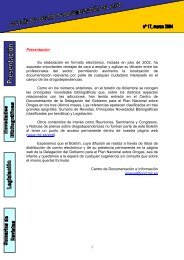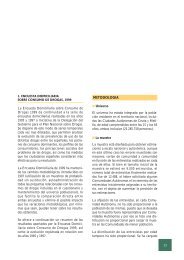MonografÃa Tabaco - Plan Nacional sobre drogas
MonografÃa Tabaco - Plan Nacional sobre drogas
MonografÃa Tabaco - Plan Nacional sobre drogas
You also want an ePaper? Increase the reach of your titles
YUMPU automatically turns print PDFs into web optimized ePapers that Google loves.
Los procedimientos de autoayuda para dejar<br />
de fumar<br />
Mª DEL CARMEN MÍGUEZ<br />
Universidad de Santiago de Compostela<br />
Enviar correspondencia a: Mª del Carmen Míguez Varela. Universidad de Santiago de Compostela. Facultad de Psicología. Departamento<br />
de Psicología Clínica y Psicobiología. Campus Universitario Sur. 15782 Santiago de Compostela. E-mail: pcmcm@usc.es<br />
RESUMEN<br />
Las intervenciones clínicas para dejar de fumar resultan<br />
insuficientes para tratar la elevada prevalencia<br />
de tabaquismo que tenemos en España y que representa<br />
un importante problema de salud pública. Además,<br />
la mayoría de los fumadores prefieren dejar de<br />
fumar por sí mismos. Por ello, es importante que se<br />
lleven a cabo procedimientos que permitan abarcar<br />
el mayor número de sujetos posible y que, al mismo<br />
tiempo, acerquen el tratamiento a los fumadores. Un<br />
recurso útil para este fin son los procedimientos de<br />
autoayuda.<br />
En este trabajo se exponen las modalidades de intervención<br />
para dejar de fumar más utilizadas desde<br />
el marco de la autoayuda y su nivel de eficacia. Se<br />
comienza por los manuales de autoayuda, siguiendo<br />
con las intervenciones por correo y las intervenciones<br />
con apoyo telefónico, en sus modalidades reactiva y<br />
proactiva. Se concluye que de los procedimientos expuestos<br />
el más utilizado es el manual de autoayuda<br />
y el que mejores resultados obtiene, y que más se<br />
asemeja a las intervenciones clínicas, es la intervención<br />
por correo con apoyo telefónico de un terapeuta<br />
(modalidad proactiva).<br />
Palabras clave: dejar de fumar, tratamiento de<br />
autoayuda, manual, correo, teléfono.<br />
ABSTRACT<br />
Taking into account the high prevalence of smokers<br />
that we have in Spain and that represents an important<br />
public health problem, it is evident that it would<br />
not be possible to do clinical programs for all them.<br />
Furthermore, most of the smokers prefer smoking<br />
cessation by themselves. Because of this, it is important<br />
that procedures are put in place that permit the<br />
treatment of a large number of subjects and makes<br />
treatment more approachable to smokers. A useful<br />
resource for this purpose is the self-help procedures.<br />
This study will consider the most commonly used<br />
self-help interventions for smoking cessation and<br />
evaluate the effectiveness of these. This begins with<br />
self-help manuals, and continuing with interventions<br />
by mail and those with telephone support, in both<br />
reactive and proactive formats. The study concludes<br />
that of the procedures analysed, the most commonly<br />
used is the self-help manual and the intervention by<br />
mail combined with telephone support by a counsellor<br />
(proactive) proves to obtain the best results as<br />
well as being the most similar to clinical procedures.<br />
Key words: smoking cessation, self-help intervention,<br />
manual, mail, telephone.<br />
INTRODUCCIÓN<br />
El tabaquismo constituye el principal<br />
problema de salud pública evitable en<br />
los países desarrollados. Su prevalencia,<br />
aunque ha descendido ligeramente en<br />
los últimos años, todavía sigue siendo demasiado<br />
elevada, y afecta, en nuestro país, al<br />
34.4% de la población mayor de 15 años<br />
(Ministerio de Sanidad y Consumo, 2003).<br />
Por ello, es necesario poner en marcha distintos<br />
procedimientos de ayuda a los fuma-<br />
ADICCIONES (2004), VOL. 16, SUPL. 2<br />
339



